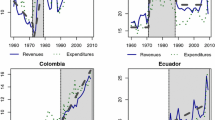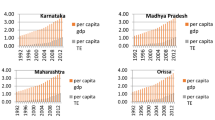Abstract
Fiscal sustainability is a central topic for most of the transition economies of Eastern Europe. This paper focuses on a particular country: Poland. The main purpose is to investigate, empirically, whether the post-transition fiscal policy is consistent with the intertemporal budget constraint, used as a formal theoretical framework. To test debt stabilization, the empirical analysis is made in two steps: first, we use a Bayesian methodology to conduct inference about the cointegrating relationship between budget revenues and (inclusive of interest) expenditures and to select the cointegrating rank. Second, we apply Bayesian inference to the estimation of the cointegrating vector and of the adjustment parameters. With a single cointegrating relation, we make use of some known results concerning the posterior density of the cointegrating vector, which belongs to the poly-t densities class. In this way, we experiment the usefulness of Bayesian inference in precisely assessing the magnitude of the cointegrating vector. Moreover, we show to what extent the likelihood of the data is important in revising the available prior information, relying on numerical integration techniques.
Similar content being viewed by others
References
Apergis N, Katrakilidis KP, Tabakis NM (2000) Current account deficit sustainability: the case of Greece. Appl Econ Lett 7: 599–603
Arghyrou MG, Luintel KB (2007) Government solvency: revisiting some EMU countries. J Macroecon 29: 387–410
Bartlett MS (1957) A comment on D. V. Lindley’s statistical paradox. Biometrika 44: 533–534
Bauwens L, Giot P (1998) A Gibbs sampler approach to cointegration. Comput Stat 13: 339–368
Bauwens L, Lubrano M (1996) Identification restrictions and posterior densities in cointegrated Gaussian VAR systems. In: Fomby TB, Hill RC (eds) Advances in econometrics. Bayesian methods applied to time series data, vol 11B. JAI Press, Greenwich, pp 3–28
Bauwens L, Lubrano M, Richard J-F (1999) Bayesian inference in dynamic econometric models. Oxford University Press, Oxford
Box GEP, Tiao GC (1973) Bayesian inference in statistical analysis. Addison-Wesley, Reading
Budina N, van Wijnbergen S (1997) Fiscal policies in Eastern Europe. Oxf Rev Econ Policy 3: 47–64
Buiter WH (1996) Aspects of fiscal performance in some transition economies under fund-supported programs. Centre for Economic Policy Research discussion paper no. 1535
Buiter WH (2005) Joys and pains of public debt. In: Gijsel P, Schenk H (eds) Multidisciplinary economics: the birth of a New Economics Faculty in the Netherlands. Springer, Berlin, pp 209–224
Caporale G (1995) Bubble finance and debt sustainability: a test of the government’s intertemporal budget constraint. Appl Econ 27: 1135–1143
Corsetti G, Roubini N (1991) Deficits, public debt and government solvency: evidence from OECD countries. J Jpn Int Econ 5: 354–380
Drèze JH (1977) Bayesian regression analysis using poly-t densities. J Econom 6: 329–354
Fonseca Marinheiro C (2006) The sustainability of Portuguese fiscal policy from a historical perspective. Empirica 33: 155–179
Geweke J (1996) Bayesian reduced rank regression in econometrics. J Econ 75: 121–146
Green CJ, Holmes MJ, Kowalski T (2001) Poland: a successful transition to budget sustainability. Emerg Markets Rev 2: 161–183
Greiner A, Koeller U, Semmler W (2006) Testing the sustainability of German fiscal policy: evidence for the period 1960–2003. Empirica 33: 127–140
Haber G, Neck R (2006) Sustainability of Austrian public debt: a political economy perspective. Empirica 33: 141–154
Hakkio CS, Rush M (1991) Is the budget deficit ‘too large’?. Econ Inq 24: 429–445
Hamilton JD, Flavin M (1986) On the limitations of government borrowing: a framework for empirical testing. Am Econ Rev 76: 808–819
Haug AA (1991) Cointegration and government borrowing constraints: evidence for the US. J Bus Econ Stat 9: 97–101
Johansen S (1996) Likelihood-based inference in cointegrated vector autoregressive processes. 2. Oxford University Press, Oxford
Kalyoncu H (2005) Fiscal policy sustainability: test of intertemporal borrowing constraints. Appl Econ Lett 12: 957–962
Kleibergen F, van Dijk HK (1994) On the shape of the likelihood/posterior in cointegration models. Econ Theory 10: 514–551
Kleibergen F, Paap R (2002) Priors, posteriors and Bayes factors for a Bayesian analysis of cointegration. J Econom 111: 223–249
Koop G, Strachan RW, van Dijk HK, Villani M (2006) Bayesian approaches to cointegration. In: Mills TC, Patterson K (eds) Palgrave handbook on econometrics. Econometric theory, vol 1. Palgrave MacMillan, Basingstoke, pp 871–898
Ljungqvist L, Sargent TJ (2004) Recursive macroeconomic theory, 2nd edn. The MIT Press, Cambridge/ London
Lütkepohl H (2007) New introduction to multiple time series analysis. Springer, Berlin
MacKinnon JG, Haug A, Michelis L (1999) Numerical distribution functions of the likelihood ratio tests for cointegration. J Appl Econom 14: 563–577
Martin GM (2000) US deficit sustainability: a new approach on multiple endogenous breaks. J Appl Econom 15: 83–105
Payne J (1997) International evidence on the sustainability of budget deficits. Appl Econ Lett 12: 775–779
Quintos CE (1995) Sustainability of the deficit process with structural shifts. J Bus Econ Stat 13: 409–417
Reinhart CM, Rogoff KS, Savastano MA (2003) Debt intolerance. NBER Working Paper No. 9908, August
Silvestrini A (2007) Testing fiscal sustainability in Poland: a Bayesian analysis of cointegration. CORE Discussion Paper 2007/80. Université catholique de Louvain, Belgium
Strachan RW (2003) Valid Bayesian estimation of the cointegrating error correction model. J Bus Econ Stat 21: 185–195
Strachan RW, van Dijk HK (2003) Bayesian model selection with an uninformative prior. Oxf Bull Econ Stat 65: 863–876
Strachan RW, van Dijk HK (2004) Valuing structure, model uncertainty and model averaging in vector autoregressive processes. Econometric Institute report EI 2004–2023. Erasmus University Rotterdam, Netherlands
Strachan RW, Inder B (2004) Bayesian analysis of the error correction model. J Econom 123: 307–325
Tompa H (1973) The iterative Simpson method of numerical integration. CORE Discussion Paper 7336. Université catholique de Louvain, Belgium
Trehan B, Walsh CE (1988) Common trends, intertemporal budget balance, and revenue smoothing. J Econ Dyn Control 12: 425–444
Trehan B, Walsh CE (1991) Testing intertemporal budget constraints: theory and applications to US federal budget and current account deficits. J Money Credit Banking 23: 206–223
van Dijk HK (2002) On Bayesian structural inference in a simultaneous equation model. Econometric Institute report EI 2002–2010. Erasmus University Rotterdam, Netherlands
Vanhorebeek F, Van Rompuy P (1995) Solvency and sustainability of fiscal policies in the EU. De Economist 143: 457–473
Villani M (2001) Bayesian reference analysis of cointegration. Research report 2001:1. Department of Statistics, Stockholm University, Sweden
Villani M (2005) Bayesian reference analysis of cointegration. Econom Theory 21: 326–357
Warne A (2006) Bayesian inference in cointegrated VAR models with applications to the demand for Euro area M3. ECB working paper no. 692
Westerlund J, Prohl S (2007) Testing for fiscal sustainability within the European Union: new evidence based on panel data. Mimeo
Wilcox DW (1989) The sustainability of government deficits: implications of the present-value borrowing constraint. J Money Credit Banking 21: 291–306
Author information
Authors and Affiliations
Corresponding author
Rights and permissions
About this article
Cite this article
Silvestrini, A. Testing fiscal sustainability in Poland: a Bayesian analysis of cointegration. Empir Econ 39, 241–274 (2010). https://doi.org/10.1007/s00181-009-0303-9
Received:
Accepted:
Published:
Issue Date:
DOI: https://doi.org/10.1007/s00181-009-0303-9




